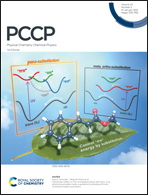A non-perturbative pairwise-additive analysis of charge transfer contributions to intermolecular interaction energies†
Abstract
Energy decomposition analysis (EDA) based on absolutely localized molecular orbitals (ALMOs) decomposes the interaction energy between molecules into physically interpretable components like geometry distortion, frozen interactions, polarization, and charge transfer (CT, also sometimes called charge delocalization) interactions. In this work, a numerically exact scheme to decompose the CT interaction energy into pairwise additive terms is introduced for the ALMO-EDA using density functional theory. Unlike perturbative pairwise charge-decomposition analysis, the new approach does not break down for strongly interacting systems, or show significant exchange–correlation functional dependence in the decomposed energy components. Both the energy lowering and the charge flow associated with CT can be decomposed. Complementary occupied–virtual orbital pairs (COVPs) that capture the dominant donor and acceptor CT orbitals are obtained for the new decomposition. It is applied to systems with different types of interactions including DNA base-pairs, borane-ammonia adducts, and transition metal hexacarbonyls. While consistent with most existing understanding of the nature of CT in these systems, the results also reveal some new insights into the origin of trends in donor–acceptor interactions.



 Please wait while we load your content...
Please wait while we load your content...
